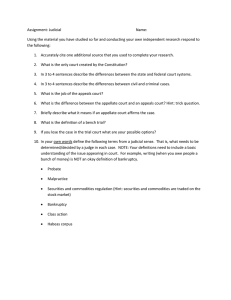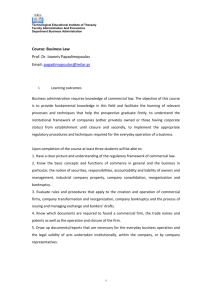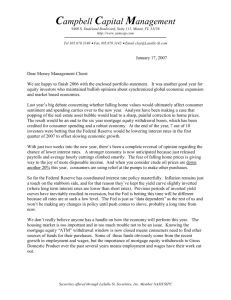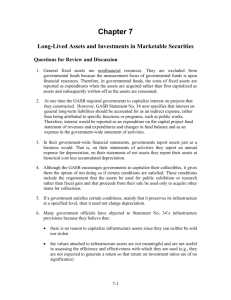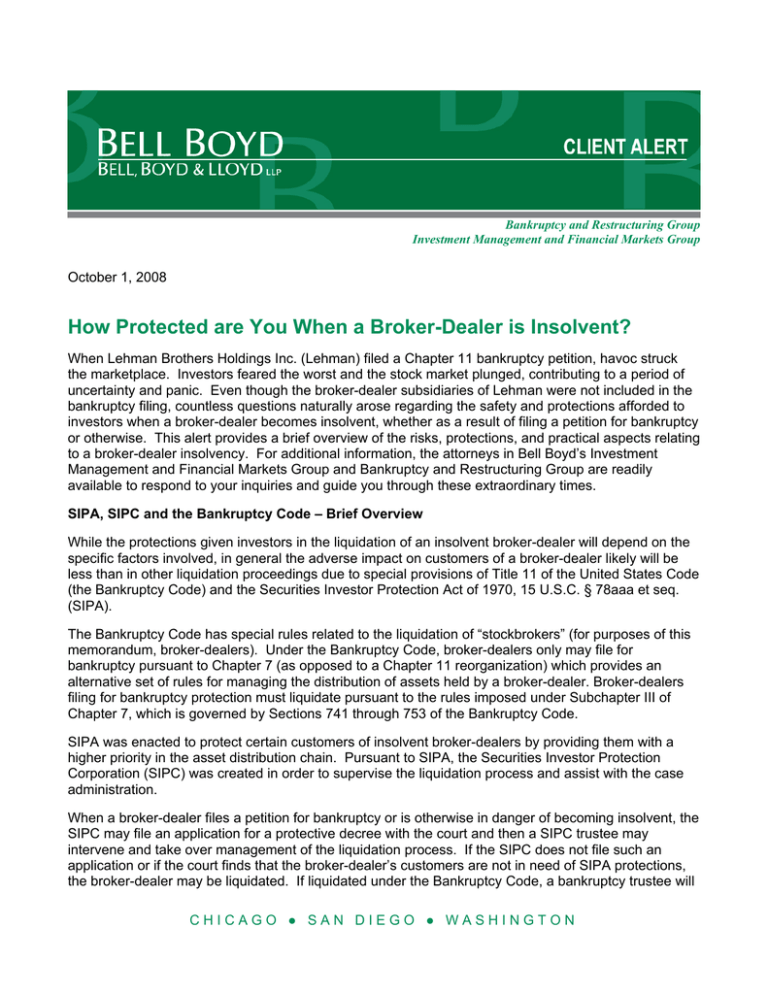
Bankruptcy and Restructuring Group
Investment Management and Financial Markets Group
October 1, 2008
How Protected are You When a Broker-Dealer is Insolvent?
When Lehman Brothers Holdings Inc. (Lehman) filed a Chapter 11 bankruptcy petition, havoc struck
the marketplace. Investors feared the worst and the stock market plunged, contributing to a period of
uncertainty and panic. Even though the broker-dealer subsidiaries of Lehman were not included in the
bankruptcy filing, countless questions naturally arose regarding the safety and protections afforded to
investors when a broker-dealer becomes insolvent, whether as a result of filing a petition for bankruptcy
or otherwise. This alert provides a brief overview of the risks, protections, and practical aspects relating
to a broker-dealer insolvency. For additional information, the attorneys in Bell Boyd’s Investment
Management and Financial Markets Group and Bankruptcy and Restructuring Group are readily
available to respond to your inquiries and guide you through these extraordinary times.
SIPA, SIPC and the Bankruptcy Code – Brief Overview
While the protections given investors in the liquidation of an insolvent broker-dealer will depend on the
specific factors involved, in general the adverse impact on customers of a broker-dealer likely will be
less than in other liquidation proceedings due to special provisions of Title 11 of the United States Code
(the Bankruptcy Code) and the Securities Investor Protection Act of 1970, 15 U.S.C. § 78aaa et seq.
(SIPA).
The Bankruptcy Code has special rules related to the liquidation of “stockbrokers” (for purposes of this
memorandum, broker-dealers). Under the Bankruptcy Code, broker-dealers only may file for
bankruptcy pursuant to Chapter 7 (as opposed to a Chapter 11 reorganization) which provides an
alternative set of rules for managing the distribution of assets held by a broker-dealer. Broker-dealers
filing for bankruptcy protection must liquidate pursuant to the rules imposed under Subchapter III of
Chapter 7, which is governed by Sections 741 through 753 of the Bankruptcy Code.
SIPA was enacted to protect certain customers of insolvent broker-dealers by providing them with a
higher priority in the asset distribution chain. Pursuant to SIPA, the Securities Investor Protection
Corporation (SIPC) was created in order to supervise the liquidation process and assist with the case
administration.
When a broker-dealer files a petition for bankruptcy or is otherwise in danger of becoming insolvent, the
SIPC may file an application for a protective decree with the court and then a SIPC trustee may
intervene and take over management of the liquidation process. If the SIPC does not file such an
application or if the court finds that the broker-dealer’s customers are not in need of SIPA protections,
the broker-dealer may be liquidated. If liquidated under the Bankruptcy Code, a bankruptcy trustee will
CHICAGO ● SAN DIEGO ● WASHINGTON
be appointed to reduce assets to cash and make distributions to creditors. Although SIPA does not
require the SIPC to file an application for a protective decree, more often than not, a SIPC trustee will
intervene based on his or her expertise and vested interest in the liquidation process.
The main difference between a broker-dealer liquidation under SIPA as compared to under the
Bankruptcy Code is that a SIPC trustee is required to distribute securities to customers to the greatest
extent practicable in satisfaction of their claims against the broker-dealer. Conversely, with certain
exceptions, a bankruptcy trustee must convert the securities to cash for distribution.
Primary Factors That May Affect Customer Protections
Customer Name vs. Street Name – Which Provides Greater Protection to the Customer?
Unfortunately, if disaster strikes and a broker-dealer is insolvent, securities held in “street name” are not
afforded the same protections as securities held in “customer name.”
Street name securities are held in the name of the broker-dealer or a custodian. In today’s
marketplace, securities are more commonly held in street name and rarely held in the customer’s
name. Even though holding securities in the customer’s name provides for greater protection to the
investor, for numerous reasons, broker-dealers rarely allow customers to hold their securities in
customer name. Unlike customer name securities, street name securities provide a broker-dealer with
more freedom and flexibility. Among other things, a security held in a customer’s name makes it
extremely difficult for the broker-dealer to operate and manage securities efficiently. Every time an
action needs to be taken with respect to a customer name security, the broker-dealer must obtain
authorization from the customer to negotiate the security – a major administrative burden. Moreover, if
a margin call is ever made, similar hurdles must be overcome whereby the broker-dealer would be
forced to contact and obtain approval from the customer to liquidate or take other action regarding such
securities. Thus, the timing delays resulting from handling customer name securities pose an additional
risk, which may result in financial losses.
Net Equity – How Much Can the Customer Expect to Receive in a Distribution? A customer of a
broker-dealer will only receive a distribution in liquidation up to the amount of his or her net equity, and
nothing more. A customer with a negative net equity will not receive a distribution.
Net equity is the dollar amount of the customer's account determined by calculating the liquidation
value of all positions on the date of the bankruptcy filing, subtracting any indebtedness of the customer
to the debtor on the filing date, and adding any payment of that indebtedness made with the approval of
the trustee. In short, net equity is the difference between what is owed to the customer by the debtor
and what is owed by the customer to the debtor. Importantly, if a customer holds multiple accounts with
the same broker-dealer but in separate capacities, the broker-dealer is not allowed to offset a negative
equity in one of the customer's accounts against a positive net equity in another one of that same
customer's accounts.
Specifically Identifiable Property vs. Customer Property – Which Provides Greater Protection to
the Customer? Ultimately, “specifically identifiable property” is well-protected in a SIPA proceeding
but is treated as “customer property” in a Bankruptcy Code proceeding. “Customer property” is
generally afforded less protection in both SIPA and Bankruptcy Code proceedings.
“Specifically identifiable property” consists of securities registered in customers’ names and other
specifically identifiable property that has remained in its identical form or which has been allocated to or
physically set aside for the customer as of the date of the bankruptcy filing. It does not include
securities held by brokers in street name. “Customer property” includes cash and securities (other than
“customer name securities” as described below) at any time received, acquired or held by or for the
2
account of the debtor from or for the securities accounts of a customer, and the proceeds of any such
property transferred by the debtor, including property unlawfully converted.
In a SIPA proceeding, the trustee must first return specifically identifiable property to customers.
Customer property is distributed pro rata. Thus, customer property is not afforded the same degree of
protection under SIPA as “specifically identifiable property.”
The treatment of "specifically identifiable property" under the Bankruptcy Code varies from its treatment
under SIPA, with the Bankruptcy Code relying on the presumption that customers prefer to receive
cash (and not securities) in satisfaction of their claims. In a Chapter 7 bankruptcy, the bankruptcy
trustee actually will sell specifically identifiable property in order to convert it to cash for distribution.
Under the Bankruptcy Code, customer property also includes the cash received from the sale of
specifically identifiable property, and, unlike SIPA, the Bankruptcy Code provides that this cash is
distributed pro rata as part of the customer property pool.
Alternatively, “customer name securities” are not considered customer property, and are essentially
treated like a secured claim. These securities only include non-transferable securities that are
registered or in the process of being registered in a customer’s own name, and must not be
transferable by delivery, power of attorney or otherwise. So long as the customer does not have a
negative net equity, customer name securities are distributed ahead of customer property. Customer
name securities are not equivalent to specifically identifiable property.
SIPC Insurance Coverage – Who and What is Covered? SIPC will supplement a distribution, if
necessary, up to a limit of $500,000 per customer, including a maximum of $100,000 for cash claims in
securities accounts. Accordingly, when there is a shortfall in securities available for distribution and the
SIPC insurance kicks in, a SIPC trustee will purchase additional securities – subject to the extent of the
coverage – and distribute those additional securities to investors.
In bankruptcy proceedings for unregistered broker-dealers, SIPC funds are not available for distribution
to investors. It is important to note, however, that most registered broker-dealers in today’s market
carry SIPC insurance. In determining the extent of SIPC insurance coverage, the term “customer”
includes any person who has a claim against the broker-dealer arising out of the sale or exchange of
securities and has deposited cash with the broker-dealer for the purpose of purchasing securities, but
does not include claims in connection with transactions entered into with a foreign affiliate of a SIPC
member, a capital transaction with the broker-dealer, or claims subordinated to the broker’s creditors.
Practical Recommendations
•
Most importantly, stay alert! Read newspaper articles, periodically check financial Web sites such
as CNBC, and maintain regular contact with your securities broker.
•
Diversify, Diversify, Diversify! Individuals should consider diversifying among brokers, as hedge
funds and other institutional customers have done. Having multiple accounts allows investors to
avoid a loss or delay to all of their securities and to transfer their assets quickly should one of their
brokers show signs of financial distress
•
As mentioned above, SIPC funds are not always available and are subject to dollar amount
limitations. Thus, as a practical matter, investors should inquire with their broker-dealer to see
whether it carries supplemental insurance that provides coverage in excess of SIPC coverage and
the extent of such coverage.
3
•
Although many brokers are unwilling to do so, consider holding at least a portion of your assets in
“customer name” and taking possession of stock certificates or maintaining accounts through the
issuer whose securities you have purchased. This may be recommended only for longer term
investments not purchased on margin.
•
Customers should consider placing some of their assets with an independent custodian such as a
bank or trust company, and remove some of their investments from the control of a broker-dealer.
Holding money in a trust account, for example, provides for increased protection of an investor’s
assets. In the event of a bankruptcy of a bank or trust company, the segregated trust account will
generally not be considered part of the bankrupt’s estate.
•
Investors should consider reducing the amount of cash held by their brokers and instead have their
broker invest that money in highly liquid and safe securities such as Treasury bills or other
government instruments or instruct the broker to sweep any excess cash into a money market fund.
As discussed above, SIPC insurance provides a higher dollar threshold of protection for securities
than it does for cash. Moreover, a SIPC trustee is likely to distribute securities sooner than he or
she would distribute cash.
•
Even in a SIPC proceeding which proceeds rather quickly, it may take up to 90 days for a security
to be returned in a distribution. During that time, investors are at the risk of the market and can only
sit and watch as their securities change in value. Thus, investors should be aware of that risk and
consider hedging their investments accordingly.
For more information about this client alert, please contact Donald Weiss (312-807-4303,
dweiss@bellboyd.com), of Bell Boyd's Investment Management and Financial Markets Group.
For further information, please contact Jeff Heller 312-781-7169, James Morgan 312-781-7234, or Robert Shannon 312-8074337 of Bell, Boyd & Lloyd LLP’s Bankruptcy and Restructuring Group, or Cheryl Allaire 858-509-7424, Cameron Avery 312807-4302, Kevin Bettsteller 312-807-4442, Paul Dykstra 312-781-6029, David Glatz 312-807-4295, Alan Goldberg 312-8074227, Mark Greer 312-807-4393, Elizabeth Hudson 312-807-4376, Stevens Kelly 312-807-4240, Molly Moynihan 202-9557027, Anna Paglia 312-781-7163, Joanne Phillips 202-955-6824, Paulita Pike 312-781-6027, Eric Purple 202-955-7081, Bruce
Rosenblum 202-955-7087, Donald Weiss 312-807-4303, Gwendolyn Williamson 202-955-7059, or Stacy Winick 202-955-7040
of Bell, Boyd & Lloyd’s Investment Management and Financial Markets Group or visit our Web site at www.bellboyd.com.
This publication has been prepared by the Bankruptcy and Restructuring Group and the Investment Management and
Financial Markets Group of Bell, Boyd & Lloyd LLP for clients and friends of the firm and is for information only. It is not a
substitute for legal advice or individual analysis of a particular legal matter. Readers should not act without seeking
professional legal counsel. Transmission and receipt of this publication does not create an attorney-client relationship.
© 2008 Bell, Boyd & Lloyd LLP All Rights Reserved
www.bellboyd.com

